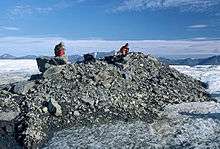Oodaaq

Oodaaq or Oodap Qeqert is the bank of gravel and silt northeast of Greenland that has been considered by some to be the most northerly point of land on earth. It was most likely created by the impact of an iceberg in shallow sea.
Location

Oodaaq lies at 83°40′N 30°40′W / 83.667°N 30.667°WCoordinates: 83°40′N 30°40′W / 83.667°N 30.667°W, only 705 km south of the North Pole and 1,360 metres north of Kaffeklubben Island, lying near the northeast tip of Greenland. When discovered it measured a mere 15 metres by 8 metres.
It was discovered in 1978 when a Danish survey team led by Uffe Petersen landed a helicopter on Kaffeklubben Island to confirm that it did indeed lie further north than the tip of Greenland. Having confirmed the fact, a member of the team spotted a dark spot to the north and they flew over to the bank, naming it Oodaaq after the Eskimo who accompanied Robert Peary on his historic journey to the North Pole.
Gravel banks such as this are generally considered not to qualify for the title of world's most northerly point of land as they are rarely permanent. In fact several subsequent expeditions have claimed that Oodaaq has now disappeared beneath the ocean.
A number of other locations have since been called the northernmost point. In July 2001, the Return to the Top of the World Expedition, led by Theresa Baker, John Jancik, and Ken Zerbst, came to the conclusion that the previously-discovered island and permanent land feature ATOW1996 is the northernmost point of land on earth.[1] In July 2003 American explorers led by Dennis Schmitt found a 35-metre-long bank at 83°42'N. Debate continues as to whether the bank is permanent although a helicopter reconnaissance in 2008 to the GPS coordinate site showed no evidence of its existence.
In late 2004, the Eighth Edition of the National Geographic World Atlas was released. It clearly shows Oodaaq as the northernmost landmass on Earth. In July 2007, Dennis Schmitt discovered a 'new' northernmost island on Earth at 83°40'30" N (named Stray Dog West by Holly Wenger).[2]
References
- ↑ Jancik, John; Richardson, Javana & Gardiner, Steve (2002). Under the Midnight Sun: The Ascent of John Denver Peak and the Search for the Northernmost Point of Land on Earth. Stars End Creations. ISBN 1-889120-19-7.
- ↑ Stray Dog West (photograph taken on 2007-07-16) belongs to a shifting, semi-permanent archipelago locked in the sea ice north of Peary Land in northeast Greenland, named the Stray Dog Islands.